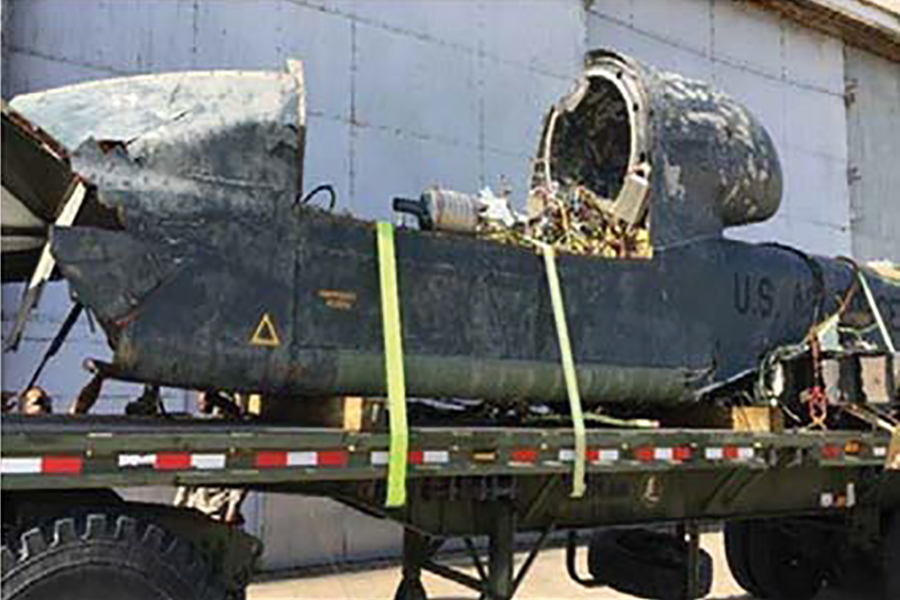A leak in a cracked oil line caused an RQ-4’s engine to fail during a ferry flight to the Middle East in June 2018, and because the operations aircrews did not properly plan divert airfields en route, the Global Hawk crashed into the sea near Spain, according to an Air Force investigation.
The RQ-4B, tail number 09-2041, operated by the 348th Reconnaissance Squadron at Grand Forks Air Force Base, N.D., was deploying to U.S. Central Command on June 26, 2018. About 11 hours and 49 minutes into the flight, the aircraft began showing engine fault codes, indicating low oil quantity and low oil pressure. Twenty-six minutes later, the aircraft’s engine shut down and the pilot tried to divert to Naval Station Rota, Spain. The pilot glided on auxiliary power for almost an hour before determining the aircraft could not make it to the airfield and decided to ditch the Global Hawk off the coast, according to an Air Combat Command Accident Investigation Board report released July 7.
The RQ-4 and its sensor system was destroyed, at a cost of $98.83 million. U.S. air and naval assets, along with contracted private submarines, searched for more than a month to recover the aircraft’s engine, fuselage, and other parts, which were strewn across an 11-nautical-mile area of the sea. Once recovered, all components were shipped back to Grand Forks for the investigation.
While the incident occurred in June 2018, Air Combat Command convened the Accident Investigation Board to find the cause of the crash in August 2019. The AIB determined that an oil line in the engine cracked, causing it to quickly leak oil and cause an uncommanded engine shutdown. The pressurized oil line, which feeds the aircraft’s accessory gear box, failed under high cycle fatigue, according to the report.
Additionally, the unit’s approved mission plan did not have sufficient emergency divert airfields, according to the report. Before the crash, the pilot glided toward Rota for almost an hour. The report states that back in 2015, the commander of the 9th Reconnaissance Wing requested 100 percent command, control, and communication (C3) coverage, though that guidance was not followed by the 348th RS in this mishap and Air Combat Command determined that since 2015, similar flights occurred with known and “acceptable gaps” of C3 coverage.
Weeks before a Global Hawk sortie, waypoints that the aircraft will follow need to be coded into the aircraft’s mission plan. The RQ-4 uses these preset locations to automatically fly without direct controls from a pilot.
An RQ-4 mission plan includes “stitched” waypoints, which are preset and automatically followed by the aircraft’s software, and “unstitched” waypoints that can be manually selected by a pilot, such as a divert location. If the mission planning does not add an airfield as an “unstitched” waypoint to be selected, a manual landing would be required; however, “pilots are not taught a manual landing. This is a critical mission planning constraint,” the report states.
In the June 2018 flight, there were three airfields in Portugal that could have been used, but because of administrative issues, had not been added to a list of available airfields.
“All of these three airfields were closer than Naval Station Rota, Spain,” the AIB states. “Any of these airfields could have been utilized by the MP if waypoints had been either stitched or unstitched into the mission plan. Since only Naval Station Rota was coded with waypoints into the mission plan, the MP was limited to either crashing the (RQ-4) into the ocean or try to make the distance to the only divert airfield available.”
Lastly, the AIB states that the RQ-4 community, and specifically the 69th Reconnaissance Group at Grand Forks, had “overconfidence” because of the Global Hawk’s “near flawless performance” over its 295,000 flight hours. At the group, “the operational pressure to meet combatant command requirements overshadowed the inherent risks of repeatedly flying long endurance sorties,” the AIB states.
